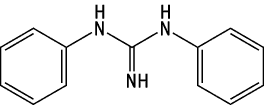

1,3-Diphenylguanidine was studied for oral toxicity in rats of both sexes in a single dose toxicity test at doses of 0, 50, 65, 85, 110 and 143 mg/kg. The single dose toxicity test revealed LD50 values of 111 mg/kg for males and 107 mg/kg for females.
1,3-Diphenylguanidine was studied for oral toxicity in rats in a 28-day repeat dose toxicity test at doses of 0, 10, 30, and 90 mg/kg. Dead or moribund animals in the 90 mg/kg group were observed during weeks 2 to 4 of the administration period. Salivation was observed in both sexes in the 30 and 90 mg/kg groups, and many other clinical signs including startle response were observed in both sexes in the 90 mg/kg group. Body weight gain and food consumption were suppressed in both sexes in the 90 mg/kg group. Hematological examination revealed an increase in platelet counts in females in the 30 mg/kg group. Blood chemistry examination revealed a decrease in blood glucose in males in the 30 and 90 mg/kg groups, and increases in blood urea nitrogen, total birilubin, A/G ratio, ALT and ALP values in males in the 90 mg/kg group. Urinalysis revealed an increase in urine volume and a decrease in specific gravity in both sexes in the 90 mg/kg group. Histopathological examination revealed increased incidences of hydropic changes in renal collecting tubules in both sexes in the 90 mg/kg group.
The NOEL for repeat dose toxicity is considered to be 10 mg/kg/day for both sexes.
1,3-Diphenylguanidine was not mutagenic in Salmonella typhimurium TA100, TA1535, TA98, TA1537 and Escherichia coli WP2 uvrA, with or without an exogenous metabolic activation system.
1,3-Diphenylguanidine did not induce structural chromosomal aberrations or polyploidy in CHL/IU cells with or without an exogenous metabolic activation system.
| Purity | : | 99.9 % |
| Test species/strains | : | Rat/Crj:CD(SD)IGS |
| Test method | : | OECD Test Guideline 401 |
| Route | : | Oral (gavage) |
| Doses | : | 0, 50, 65, 85, 110 and 143 mg/kg |
| Number of animals/group | : | Males, 5; females, 5 |
| Vehicle | : | Corn oil |
| GLP | : | Yes |
Test results:
| Purity | : | 99.9 % |
| Test species/strain | : | Rat/Crj:CD(SD)IGS |
| Test method | : | Guideline for 28-Day Repeated Dose Toxicity Test in Mammalian Species (Chemical Substances Control Law of Japan) |
| Route | : | Oral |
| Doses | : | 0(vehicle), 10, 30, 90 mg/kg/day |
| Number of animals/group | : | Males, 5; females, 5 |
| Vehicle | : | Corn oil |
| Administration period | : | Males and females, 28 days |
| Terminal kill | : | Males and females, on days 29 and 43 |
| GLP | : | Yes |
Test results:
| Purity | : | 99.9 % |
| Test species/strains | : | Salmonella typhimurium TA100, TA1535, TA98, TA1537, Escherichia coli WP2 uvrA |
| Test method | : | Guidelines for Screening Mutagenicity Testing of Chemicals(Chemical Substances Control Law of Japan) and OECD Test Guideline 471 |
| Procedures | : | Pre-incubation method |
| Solvent | : | DMSO |
| Positive controls | : | -S9 mix; 2-(2-Furyl)-3-(5-nitro-2-furyl)acrylamide (TA100, TA98), Sodium azide (TA1535), 9-Aminoacridine (TA1537) and N-Ethyl-N'-nitro-N-nitrosoguanidine (WP2 uvrA) +S9 mix; 2-Aminoanthracene (all strains) |
| Doses | : | -S9 mix; 156, 313, 625, 1250, 2500 and 5000 μg/plate(TA100, WP2 uvrA, TA98 and TA1537) -S9 mix; 39.1, 78.1, 156, 313, 625, 1250 and 2500 μg/plate(TA1535) +S9 mix; 39.1, 78.1, 156, 313, 625 and 1250 μg/plate(all strains) |
| S9 | : | Rat liver, induced with phenobarbital and 5,6-benzoflavone |
| Plates/test | : | 3 |
| Number of replicates | : | 2 |
| GLP | : | Yes |
Test results:
Genetic effects:
Salmonella typhimurium TA100, TA1535, TA98 and TA1537
| + | ? | - | |
| Without metabolic activation: | [ ] | [ ] | [*] |
| With metabolic activation: | [ ] | [ ] | [*] |
Escherichia coli WP2 uvrA
| + | ? | - | |
| Without metabolic activation: | [ ] | [ ] | [*] |
| With metabolic activation: | [ ] | [ ] | [*] |
| Purity | : | 99.9 % |
| Type of cell used | : | Chinese hamster CHL/IU cells |
| Test method | : | Guidelines for Screening Mutagenicity Testing of Chemical (Chemical Substances Control Law of Japan) and OECD Test Guideline 473 |
| Solvent | : | 1 % Sodium carboxymethylcellulose solution |
| Positive controls | : | -S9 mix; Mitomycin C +S9 mix; Benzo[a]pyrene |
| Doses | : | -S9 mix(6 hr short-term treatment); 0, 50, 100, 200, 400 μg/mL |
| S9 | : | Rat liver, induced with phenobarbital and 5,6-benzoflavone |
| Plates/test | : | 2 |
| GLP | : | Yes |
Test results:
Genotoxic effects:
| clastogenicity | polyploidy | |||||
| + | ? | - | + | ? | - | |
| Without metabolic activation: | [ ] | [ ] | [*] | [ ] | [ ] | [*] |
| With metabolic activation: | [ ] | [ ] | [*] | [ ] | [ ] | [*] |
| 1) | The tests were performed by the Biosafety Research Center, Foods, Drugs and Pesticides (An-pyo Center), Japan, 582-2 Shioshinden, Arahama, Fukude-cho, Iwata-gun, Shizuoka, 437-1213, Japan. Tel +81-538-58-1266 Fax +81-538-58-1393 |
| 2) | The tests were performed by the Mitsubishi Chemical Safety Institute Ltd., 14 Sunayama, Hasaki-machi, Kashima-gun, Ibaraki, 314-0255, Japan. Tel +81-479-46-2871 Fax +81-479-46-2874 |